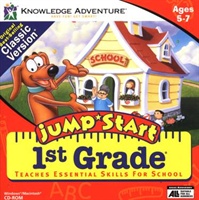JumpStart 1st Grade facts for kids
Quick facts for kids JumpStart 1st Grade |
|
|---|---|

JumpStart 1st Grade (1995) CD cover
|
|
| Developer(s) | Knowledge Adventure |
| Publisher(s) | Knowledge Adventure |
| Producer(s) | |
| Designer(s) | Barton Listick |
| Programmer(s) |
|
| Artist(s) |
|
| Composer(s) |
|
| Series | JumpStart |
| Platform(s) | Windows, Macintosh |
| Release date(s) | August 28, 1995 |
| Genre(s) | Educational |
| Mode(s) | Single-player |
JumpStart 1st Grade is a fun computer game. It was made by Knowledge Adventure in 1995. The game helps kids learn things taught in first grade. It was also known as Jump Ahead Year 1 in the United Kingdom.
The original 1995 version introduced Frankie. Frankie is a friendly brown dachshund dog. He became the main character for the JumpStart game series. The game was re-released in 1999 with new cover art. It received a big update in 2000. Later, it was replaced by JumpStart Advanced 1st Grade in 2002. That game was then replaced by JumpStart 3D Virtual World: Trouble in Town.
How the Game Works
JumpStart 1st Grade teaches school subjects in a fun way. Players explore different areas and play educational games. These games help them learn reading, math, and other skills.
The Original 1995 Game
The 1995 version of the game takes place in an interactive schoolhouse. Frankie, the school's mascot, guides players. He helps them find different activities and songs. When players complete activities, they earn points. These points could be traded for "milk cap" rewards.
The game featured many songs. These included "JumpStart First Grade" and "Reading is Fun." These songs helped make learning enjoyable.
The 2000 Update
The 2000 version of JumpStart 1st Grade had a similar idea. In this version, Frankie acts more like a student. He chooses the player to be his partner. Together, they go on a school treasure hunt.
Playing games in this version earned players clues. These clues helped them find the hidden treasure. The game had four main areas to explore. These were a classroom, a cafeteria, field trips, and a playground. Players earned 100 points to get a milk cap. There were different types of caps to collect. These included 30 green math caps and 30 red reading caps. There were also 20 yellow time caps and 20 blue nature caps.

